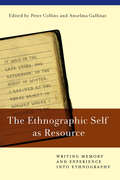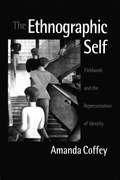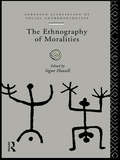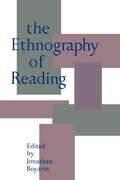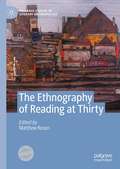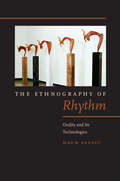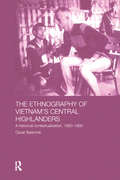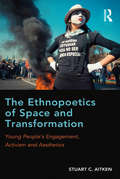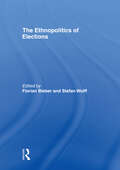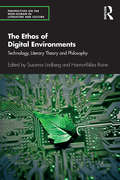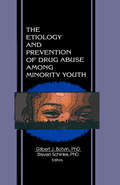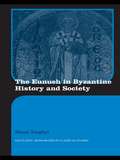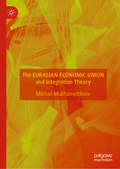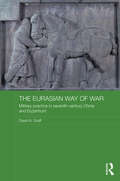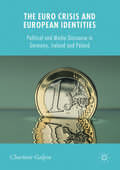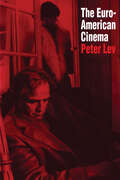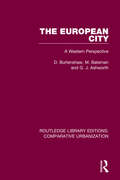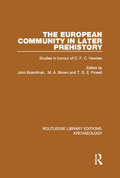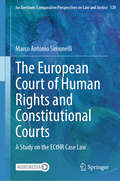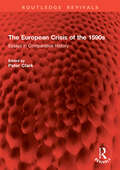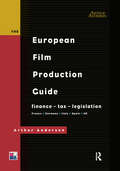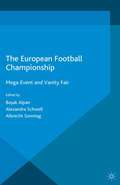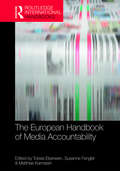- Table View
- List View
The Ethnographic Self As Resource
by Peter Collins Anselma GallinatIt is commonly acknowledged that anthropologists use personal experiences to inform their writing. However, it is often assumed that only fieldwork experiences are relevant and that the personal appears only in the form of self-reflexivity. This book takes a step beyond anthropology at home and auto-ethnography and shows how anthropologists can include their memories and experiences as ethnographic data in their writing. It discusses issues such as authenticity, translation and ethics in relation to the self, and offers a new perspective on doing ethnographic fieldwork.
The Ethnographic Self: Fieldwork and the Representation of Identity (Qualitative Ser.)
by Amanda CoffeyWhat are the relationships between the self and fieldwork? How do personal, emotional and identity issues impact upon working in the field? This book argues that ethnographers, and others involved in fieldwork, should be aware of how fieldwork research and ethnographic writing construct, reproduce and implicate selves, relationships and personal identities. All too often research methods texts remain relatively silent about the ways in which fieldwork affects us and we affect the field. The book attempts to synthesize accounts of the personal experience of ethnography. In doing so, the author makes sense of the process of fieldwork research as a set of practical, intellectual and emotional accomplishments. The book is thematically arranged, and illustrated with a wide range of empirical material.
The Ethnography of Moralities (European Association of Social Anthropologists)
by Signe HowellFocusing on the social construction of morality, The Ethnography of Moralities discusses a topic which is complex but central to the study and nature of anthropology. With the recent shift towards an interest in indigenous notions of self and personhood, questions pertaining to the moral and ethical origins of beliefs relating to human rights become increasingly relevant. Some of the questions that the contributors address are: * How is the ethical knowledge grounded? * Which social domains most profoundly articulate moral values and which are most affected?* Who defines and who enforces what is right and wrong? * What constitutes an ethical breach? Suggested answers are made with reference to empirical material so that the complexities and varieties of theoretical and methodological issues are highlighted. They are also discussed with reference to a wide array of ethnographic studies from Argentina, Mongolia, Melanesia, Yemen, Zimbabwe, Mexico, Britain and The Old Testament.
The Ethnography of Reading
by Jonathan BoyarinWriting, the subject of much innovative scholarship in recent years, is only half of what we call literacy. The other half, reading, now finally receives its due in these groundbreaking essays by a distinguished group of anthropologists and literary scholars.The essays move well beyond the simple rubric of "literacy" in its traditional sense of evolutionary advancement from oral to written communication. Some investigate reading in exotically cross-cultural contexts. Some analyze the long historical transformation of reading in the West from a collective, oral practice to the private, silent one it is today, while others demonstrate that in certain Western contexts reading is still very much a social activity. The reading situations described here range from Anglo-Saxon England to contemporary Indonesia, from ancient Israel to a Kashaya Pomo Indian reservation.Filled with insights that erase the line between orality and textuality, this collection will attract a broad readership in anthropology, literature, history, and philosophy, as well as in religious, gender, and cultural studies.
The Ethnography of Reading at Thirty (Palgrave Studies in Literary Anthropology)
by Matthew RosenThis edited volume examines what the classic text The Ethnography of Reading (Boyarin ed., 1993), and the diverse ethnographies of reading it helped inspire, can offer contemporary scholars interested in understanding the place of reading in social life. The Ethnography of Reading at Thirty brings together new research and critical reflections from an international and interdisciplinary group of scholars who have kept their ears tuned to the voices in and around the texts they encountered and constructed in the process of bringing the ethnography of reading into the twenty-first century. Rather than operating from universalist assumptions about how people interact with and make meaning from written texts, each of the present contributors draw in one way or another on the theoretical, methodological, and creative legacies of The Ethnography of Reading. Under the broad umbrella of ethnographic reader studies, they collectively explore new relations between texts, social imagination, and social action.
The Ethnography of Rhythm: Orality and Its Technologies (Verbal Arts: Studies in Poetics)
by Haun SaussyWinner of the Modern Language Association's Aldo and Jeanne Scaglione Prize for Comparative Literary StudiesWho speaks? The author as producer, the contingency of the text, intertextuality, the “device”—core ideas of modern literary theory—were all pioneered in the shadow of oral literature. Authorless, loosely dated, and variable, oral texts have always posed a challenge to critical interpretation. When it began to be thought that culturally significant texts—starting with Homer and the Bible—had emerged from an oral tradition, assumptions on how to read these texts were greatly perturbed. Through readings that range from ancient Greece, Rome, and China to the Cold War imaginary, The Ethnography of Rhythm situates the study of oral traditions in the contentious space of nineteenth- and twentieth-century thinking about language, mind, and culture. It also demonstrates the role of technologies in framing this category of poetic creation. By making possible a new understanding of Maussian “techniques of the body” as belonging to the domain of Derridean “arche-writing,” Haun Saussy shows how oral tradition is a means of inscription in its own right, rather than an antecedent made obsolete by the written word or other media and data-storage devices.
The Ethnography of Vietnam's Central Highlanders: A Historical Contextualization 1850-1990 (Anthropology of Asia)
by Oscar SaleminkThis book looks at ethnographic discourses concerning the indigenous population of Vietnam's Central Highlands during periods of christianization, colonization, war and socialist transformation, and analyses these in their relation to tribal, ethnic, territorial, governmental and gendered discourses. Salemink's book is a timely contribution to anthropological knowledge, as the ethnic minorities in Vietnam have (again) been the object of fierce academic debate. This is a historically grounded post-colonial critique relevant to theories of ethnicity and the history of anthropology, and will be of interest to graduate students of anthropology and cultural studies, as well as Vietnam studies.
The Ethnopoetics of Space and Transformation: Young People’s Engagement, Activism and Aesthetics
by Stuart C. AitkenChange is inevitable, we are told. A job is lost, a couple falls in love, children leave home, an addict joins Narcotics Anonymous, two nations go to war, a family member's health deteriorates, a baby is born, a universal health care bill is voted into law. Life comprises events over which we have considerable, partial, or little or no control. The distance between the event and our daily lives suggests a quirky spatial politics. Our lives move forward depending upon how events play out in concert with our reactions to them. Drawing on nearly three decades of geographic projects that involve ethnographies and interviews with, and stories about, young people in North and South American, Europe and Asia and using the innovative technique of ethnopoetry, Aitken examines key life-changing events to look at the interconnections between space, politics, change and emotions. Analysing the intricate spatial complexities of these events, he explores the emotions that undergird the ways change takes place, and the perplexing spatial politics that almost always accompany transformations. Aitken positions young people as effective agents of change without romanticizing their political involvement as fantasy and unrealistic dreaming. Going further, he suggests that it is the emotional palpability of youth engagement and activism that makes it so potent and productive. Pulling on the spatial theories of de Certeau, Deleuze, Massey, Agamben, Rancière, Zizek and Grosz amongst others, Aitken argues that spaces are transformative to the degree that they open the political and he highlights the complexly interwoven political, economic, social and cultural practices that simultaneously embed and embolden people in places. If we think of spaces as events and events encourage change, then spaces and people become other through complex relations. Taking poetry to be an emotive construction of language, Aitken re-visualizes, contorts and arranges people's words and gestures to
The Ethnopolitics of Elections (Association For The Study Of Nationalities Ser.)
by Stefan Wolff Florian BieberThis volume conceptualizes the dynamics underlying electoral politics in ethnically divided societies, providing empirical evidence and analysis of recent elections in such societies on a comparative and single-case basis, including case studies of Macedonia, Slovakia, Belgium, Malaysia, Singapore, Rwanda, Guyana and Trinidad and Tobago. Free and fair elections are one of the most fundamental characteristics of democratic systems. In ethnically divided societies, elections and the rules and regulations on which they are based assume special importance because they provide important levers to guarantee, or prevent, adequate representation of different communal groups in the key institutions of the state. Hence not only are elections contested vigorously, but also the electoral systems according to which they are conducted. This book was previously published as a special issue of Ethnopolitics.
The Ethos of Digital Environments: Technology, Literary Theory and Philosophy (Perspectives on the Non-Human in Literature and Culture)
by Susanna LindbergWhile self-driving cars and autonomous weapon systems have received a great deal of attention in media and research, the general requirements of ethical life in today’s digitalizing reality have not been made sufficiently visible and evaluable. This collection of articles from both distinguished and emerging authors working at the intersections of philosophy, literary theory, media, and technology does not intend to fix new moral rules. Instead, the volume explores the ethos of digital environments, asking how we can orient ourselves in them and inviting us to renewed moral reflection in the face of dilemmas they entail. The authors show how contemporary digital technologies model our perception, narration as well as our conceptions of truth, and investigate the ethical, moral, and juridical consequences of making public and societal infrastructures computational. They argue that we must make the structures of the digital environments visible and learn to care for them.
The Ethos of the Enlightenment and the Discontents of Modernity (Routledge Advances in Sociology)
by Matan OramThis book probes the sources and nature of the ‘discontents of modernity’. It proposes a new approach to the philosophic-critical discourse on modernity. The Enlightenment is widely understood to be the foundational moment of modernity. Yet despite its appeal to reason as the ultimate ground of its authority and legitimacy, the Enlightenment has had multiple historical manifestations and, therefore, can hardly be said to be a homogenous phenomenon. The present work seeks to identify a unitive element that allows us to speak of the Enlightenment. To do so, it enjoins the concept of ‘ethos’ and its relation to the ‘discontents of modernity’. This book proposes a new theoretical framework for the examination of the interrelationships between ‘critical thought’ and ‘modernity’, based on a fundamental distinction between criticism and negation. It will appeal to scholars and students of critical theory, the history of ideas, philosophy, the sociology of knowledge, and political science.
The Etiology and Prevention of Drug Abuse Among Minority Youth
by Steven Schinke Gilbert J BotvinSince 1992, marijuana use among 8th graders has tripled, among 10th graders it has nearly doubled, and its use among high school seniors has increased by 50 percent. The use of other illicit drugs is also heavily on the rise. Yet, there exists very little research and literature on the etiology and prevention of drug abuse among those most at risk--disadvantaged, inner-city, minority youth. The Etiology and Prevention of Drug Abuse Among Minority Youth is an important first step in remedying this gap in the literature and for getting at the heart of the psychosocial factors that promote and sustain drug use among minority youth.The book’s chapters evolved from a program of research funded by the National Institute on Drug Abuse and Cornell University Medical College’s Institute for Prevention Research concerning drug abuse prevention with multi-ethnic youth. So that you might learn effective strategies for intervening with at-risk adolescents and teenagers, The Etiology and Prevention of Drug Abuse Among Minority Youth discusses: correlates and predictors of alcohol and drug use community-based skills interventions how youths offset feelings of distress or self-derogation by bonding with deviant peers the advantages of community-oriented outreach programs the role of cultural factors as they shape vulnerability to adolescent alcohol and drug use the role of ethnic identity as a moderator of psychosocial risk for alcohol and marijuana use the needs of youth at high risk for future use preventing gateway drug use drug use among youth living in homeless shelters the conditions of public housing and how they affect the etiology of drug abuseAn essential tool for policymakers, social workers, clinicians, researchers, psychiatrists, and other professionals in chemical dependency and narcotics rehabilitation, The Etiology and Prevention of Drug Abuse Among Minority Youth provides you with vital insight on the causes of drug use among minority adolescents, the strengths and limitations of different intervention approaches, and incentive to find appropriate ways for working with at-risk, minority teenagers.
The Eunuch in Byzantine History and Society (Routledge Monographs in Classical Studies)
by Shaun TougherThe existence of eunuchs was one of the defining features of the Byzantine Empire. Covering the whole span of the history of the empire, from the fourth to the fifteenth centuries AD, Shaun Tougher presents a comprehensive survey of the history and roles of eunuchs, making use of extensive comparative material, such as from China, Persia and the Ottoman Empire, as well as about castrato singers of the eighteenth century of Enlightenment Europe, and self-castrating religious devotees such as the Galli of ancient Rome, early Christians, the Skoptsy of Russia and the Hijras of India. The various roles played by eunuchs are examined. They are not just found as servile attendants; some were powerful political players – such as Chrysaphius who plotted to assassinate Attila the Hun – and others were prominent figures in Orthodoxy as bishops and monks. Furthermore, there is offered an analysis of how society thought about eunuchs, especially their gender identity - were they perceived as men, women, or a third sex? The broad survey of the political and social position of eunuchs in the Byzantine Empire is placed in the context of the history of the eunuch in general. An appendix listing key eunuchs of the Byzantine Empire describing their careers is included, and the text is fully illustrated.
The Eurasian Economic Union and Integration Theory
by Mikhail MukhametdinovThis book evaluates the utility of the Eurasian Economic Union in economic, political, cultural and geostrategic dimensions. It does so through a systematic comparison of the bloc with aspects of the European Union along a number of criteria derived from integration theory. The book concludes that the EAEU is a useless undertaking, at least for Russia, in any of the integration dimensions discussed. This is so because of the inherent properties of the region, and also because of the behaviour of the member states in the context of Russia’s resistance to the West. Besides, the principles of liberal economics, endorsed by the union, contribute to asymmetries in development among its member states. In addition to a symbolic event spotlighting Russia’s regional leadership, the union appears mainly as a shop where gas is sold below market prices, and as an import base of unskilled labour for Russia in conditions of Russia’s high unemployment and underemployment. Concurrently, the book discusses Russia’s grievances with the West, which have been inducing and constraining Eurasian integration at the same time.
The Eurasian Way of War: Military Practice in Seventh-Century China and Byzantium (Asian States and Empires)
by David A. GraffThis book is a comparative study of military practice in Sui-Tang China and the Byzantine Empire between approximately 600 and 700 CE. It covers all aspects of the military art from weapons and battlefield tactics to logistics, campaign organization, military institutions, and the grand strategy of empire. Whilst not neglecting the many differences between the Chinese and Byzantines, this book highlights the striking similarities in their organizational structures, tactical deployments and above all their extremely cautious approach to warfare. It shows that, contrary to the conventional wisdom positing a straightforward Western way of war and an "Oriental" approach characterized by evasion and trickery, the specifics of Byzantine military practice in the seventh century differed very little from what was known in Tang China. It argues that these similarities cannot be explained by diffusion or shared cultural influences, which were limited, but instead by the need to deal with common problems and confront common enemies, in particular the nomadic peoples of the Eurasian steppes. Overall, this book provides compelling evidence that pragmatic needs may have more influence than deep cultural imperatives in determining a society’s "way of war."
The Eureka! Moment: 100 Key Scientific Discoveries of the 20th Century
by Rupert LeeFirst Published in 2003. Routledge is an imprint of Taylor & Francis, an informa company.
The Euro Crisis and European Identities
by Charlotte GalpinThis book builds upon our knowledge of the far-reaching economic, political and social effects of the Euro crisis on the European Union by providing a unique study of European identities. In particular, it considers the impact on the construction of European identities in political and media discourse in Germany, Ireland and Poland--three countries with profoundly different experiences of the crisis and never before compared in a single study. Offering an original insight into the dynamics of identity change at moments of upheaval, the author argues that political and media actors in the early stages of the crisis drew on long-standing identities in order to make sense of the crisis in the public sphere. European identity discourses are thus resilient to change but become central to legitimising and contesting bailouts and further economic integration. As such, the author challenges the commonly held view that identities change dramatically at times of crisis but argues that this very resilience helps to understand the EU's current divisions. The study of identity during the Euro crisis sheds important light on the prospects for European solidarity as well as on the future of the single currency as an identity-building project. The book will be of particular interest to students and scholars in the fields of EU politics, comparative European politics, and identity politics.
The Euro-American Cinema (Texas Film and Media Studies Series)
by Peter LevFrom as scholar of mass communications, an international study of the influence of Hollywood movies on twentieth-century European art films. With McDonalds in Moscow and Disneyland in Paris and Tokyo, American popular culture is spreading around the globe. Regional, national, and ethnic cultures are being powerfully affected by competition from American values and American popular forms. This literate and lively study explores the spread of American culture into international cinema as reflected by the collision and partial merger of two important styles of filmmaking: the Hollywood style of stars, genres, and action, and the European art film style of ambiguity, authorial commentary, and borrowings from other arts. Peter Lev departs from the traditional approach of national cinema histories and discusses some of the blends, overlaps, and hegemonies that are typical of the world film industry of recent years. In Part One, he gives a historical and theoretical overview of what he terms the &“Euro-American art film,&” which is characterized by prominent use of the English language, a European art film director, cast and crew from at least two countries, and a stylistic mixing of European art film and American entertainment. The second part of Lev&’s study examines in detail five examples of the Euro-American art film: Contempt (1963), Blow-Up (1966), The Canterbury Tales (1972), Paris, Texas (1983), and The Last Emperor (1987). These case studies reveal that the European art film has had a strong influence on world cinema and that many Euro-American films are truly cultural blends rather than abject takeovers by Hollywood cinema.
The European City: A Western Perspective
by G. J. Ashworth D. Burtenshaw M. BatemanOriginally published in 1991, this book focusses on the philosophies, histories and processes which have made the West European city system rich in internal variety yet distinct from that of the rest of western industrialised urban society. It synthesizes international experiences in particular aspects of urban policy making, with reference to Germany, France and Benelux. The book covers urban planning in its broadest sense – from economic, socio-spacial, recreational, housing and transport perspectives.
The European Community in Later Prehistory: Studies in Honour of C. F. C. Hawkes (Routledge Library Editions: Archaeology)
by JOHN BOARDMAN, M. A. BROWN AND T. G. E. POWELLThe essays collected together in this volume were written in honour of Professor Christopher Hawkes, in recognition of his stature as an international scholar and his generosity in encouraging the work of others. The collection consists of a closely-knit group of studies, and includes contributions from continental scholars. The topics covered range from links between the Mycenaean and Greek worlds, European body-armour, firedogs in Iron Age Britain to Bronzes in Hungary. Originally published in 1971.
The European Court of Human Rights and Constitutional Courts: A Study on the ECtHR Case Law (Ius Gentium: Comparative Perspectives on Law and Justice #120)
by Marco Antonio SimonelliThis book investigates the relationship between the European Court of Human Rights (ECtHR) and national constitutional courts by providing a more general assessment as seen from the former’s perspective. Adopting an empirical approach, the book reviews all the case law of the ECtHR in which constitutional courts are cited. This represents more than 3,000 rulings spanning more than fifty years, from the establishment of the Strasbourg Court in 1959 – when only three constitutional courts were active – to 1 January 2023, when there were more than thirty active constitutional courts in the Council of Europe’s Member States. This wide-ranging empirical study pursue several different goals. First, the book provides a quantitative assessment of the relevance of constitutional courts in ECtHR case law and presents weighted data on the frequency and chronological evolution of the citations, as well as individual statistics for each national constitutional court. Second, it assesses the extent of the rationalisation of constitutional justice systems conducted by the Strasbourg Court and defines the standards and elements of the right to a fair constitutional trial under Article 6 ECHR. Finally, combining this extensive dataset with qualitative analysis, the book evaluates how the Strasbourg Court interacts with each constitutional jurisdiction and provides a qualitative assessment of this relationship from the standpoint of Strasbourg case law.
The European Crisis of the 1590s: Essays in Comparative History (Routledge Revivals)
by Peter ClarkFirst published in 1985, The European Crisis of the 1590s (now with a new preface by Peter Clark on the current literature on crisis and catastrophe) investigates in depth for the first time the origin and scale of the critical problems of the 1590s and their impact on European society. Among the contributors are many leading scholars working on European history during the sixteenth and seventeenth centuries.The book is divided into two parts. The first analyses the particular mesh of difficulties in different areas of Europe, covering all the major countries—England, France, Germany, the Netherlands, Spain, and Italy. The second part discusses more general issues such as the impact of war and the role of the state. From a systematic, comparative examination of one period of acute difficulty and upheaval we gain valuable insights into the general nature of the economic and social crises which recurred in the early modern era. Important and vivid light is also shed on the long-term social, economic, and institutional changes affecting European countries c.1550-c.1650. General findings are emphasised in the editorial introduction and in the wide-ranging conclusion by J.H. Eliott which offers a powerful evaluation of the historical significance of the 1590s.This volume will be essential reading for academics, students and others interested in the economic, social, and political history of Britain and continental Europe during the sixteenth and seventeenth centuries. It will also be valuable for all those working in the new field of crisis and catastrophe.
The European Film Production Guide: Finance - Tax - Legislation France - Germany - Italy - Spain - UK (Blueprint Ser.)
by Arthur AndersenThe European Film Production Guide sets out in one comprehensive volume the major economic, financial and business considerations which independent producers need to bear in mind when making films in or with other countries within Europe. Arthur Andersen provides creative solutions for its clients through audit, tax, business advisory and speciality consulting services. Its professsionals combine extensive technical competence and industry experience with innovative and progressive thought, enabling Arthur Anderson to exceed client expectations.
The European Football Championship: Mega-Event and Vanity Fair (Football Research in an Enlarged Europe)
by Basak Alpan Alexandra Schwell Albrecht SonntagThe UEFA European football championship was the first European mega-event to take place in post-socialist Europe. Taking this as a departure point, this volume focuses on football as a realm of constructing and negotiating identities using rich ethnographic fieldwork and in-depth media analysis.
The European Handbook of Media Accountability (Routledge International Handbooks)
by Matthias Karmasin Tobias Eberwein Susanne FenglerIn recent years, the Leveson Inquiry in Great Britain, as well as the EU High-Level Group on Media Freedom and Pluralism, have stirred heated debates about media accountability and media self-regulation across Europe. How responsible are journalists? How well-developed are infrastructures of media self-regulation in the different European countries? How much commitment to media accountability is there in the media industry – and how actively do media users become involved in the process of media criticism via social media? With contributions from leading scholars in the field of journalism and mass communication, this handbook brings together reports on the status quo of media accountability in all EU members states as well as key countries close to Europe, such as Turkey and Israel. Each chapter provides an up-to-date overview of media accountability structures as well as a synopsis of relevant research, exploring the role of media accountability instruments in each national setting, including both media self-regulation (such as codes of ethics, press councils, ombudspersons) and new instruments that involve audiences and stakeholder groups (such as media blogs and user comment systems). A theoretically informed, cross-national comparative analysis of the state of media accountability in contemporary Europe, this handbook constitutes an invaluable basis for further research and policy-making and will appeal to students and scholars of media studies and journalism, as well as policy-makers and practitioners.
